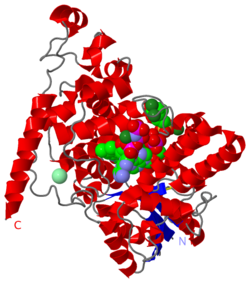JMS/sandbox22
From Proteopedia
(Difference between revisions)
| Line 15: | Line 15: | ||
'''Molecular Tour:''' | '''Molecular Tour:''' | ||
| - | The cryptochrome protein obsorbs a single phton of blue light of 2.7 eV which excites an <scene name='58/585079/1u3d_magnet/2'>FAD ligand in its interior</scene> (the atoms involved in resonance are shown with halos). FAD is protonated by a <scene name='58/585079/1u3d_magnet/15'>nearby aspartic amino acid</scene> (the proximate donors shown with halos), and the electron hole is filled through a series of electron transfers - a chain reaction involving | + | The cryptochrome protein obsorbs a single phton of blue light of 2.7 eV which excites an <scene name='58/585079/1u3d_magnet/2'>FAD ligand in its interior</scene> (the atoms involved in resonance are shown with halos). FAD is protonated by a <scene name='58/585079/1u3d_magnet/15'>nearby aspartic amino acid</scene> (the proximate donors shown with halos), and the electron hole is filled through a series of electron transfers - a chain reaction - involving <scene name='58/585079/1u3d_magnet/21'>three tryptophan amino acids</scene> (the nitrogen donors shown with halos). At this stage, FAD is in its active signalling state, and also the extra electron on FAD and lone electron on the final tryptophan amino acid (324) <scene name='58/585079/1u3d_magnet/18'>form a radical pair</scene> (location of the electron shown with halos). The pair is entangled, such that they spin in opposite or same directions, but only when they spin in the opposite directions, can the extra electron on FAD tunnel back to the hole left in tryptophan 324. |
Researchers Klaus Schulten at University Illinois at Urbana Champaign and Ilya Solov'yov, now at the University of Southern Denmark, connect this system to the fascinating ability of many birds, and other flying species, to migrate while sensing the earth's magnetic field. Through simulations, they show that where the bird's cryptochrome compass's "FAD-trp324 needle" is aligned with the line extending between the poles, the entangled electrons will 'on average' spend more time in the same spinning state (also known as triplet; or parallel), and therefore by delaying the electrons return to trp324, FAD will 'on average' be in its signalling mode for longer. | Researchers Klaus Schulten at University Illinois at Urbana Champaign and Ilya Solov'yov, now at the University of Southern Denmark, connect this system to the fascinating ability of many birds, and other flying species, to migrate while sensing the earth's magnetic field. Through simulations, they show that where the bird's cryptochrome compass's "FAD-trp324 needle" is aligned with the line extending between the poles, the entangled electrons will 'on average' spend more time in the same spinning state (also known as triplet; or parallel), and therefore by delaying the electrons return to trp324, FAD will 'on average' be in its signalling mode for longer. | ||
Revision as of 22:10, 4 August 2014
| |||||||||||
References:
- ↑ Solov'yov IA, Chandler DE, Schulten K. Magnetic field effects in Arabidopsis thaliana cryptochrome-1. Biophys J. 2007 Apr 15;92(8):2711-26. Epub 2007 Jan 26. PMID:17259272 doi:http://dx.doi.org/10.1529/biophysj.106.097139
- Cryptochrome and Magnetic Sensing, Theoretical and Computational Biophysics Group at the University of Illinois at Urbana-Champaign

